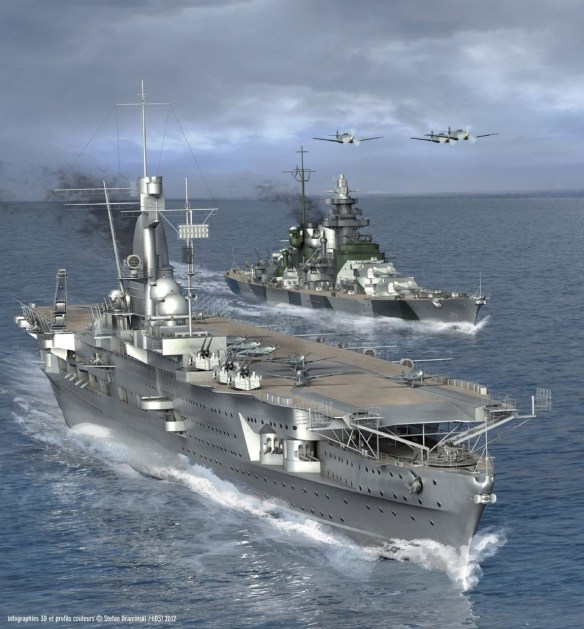Thus far, construction plans had been conceived in an atmosphere of ‘no war with Britain’. Raeder informed Hitler on several occasions that Germany’s naval development was not sufficient to cope with a war against a major sea power, but each time the Führer replied by saying there would be no war against Britain because such an act would signal the end of the Reich. Not until early 1938 did Hitler tell Raeder that the Kriegsmarine might have to consider meeting the Royal Navy on a war footing. Even then, he stressed that it would not be before 1948 at the earliest.
By 1937, warship development had progressed sufficiently for the first long-term planning policy to be effected. The plan was intended to remain in force for the years from 1938 until 1948, and would see the fleet develop to the limits of the Anglo-German Naval Agreement. All the original demands and suggestions for new warships were evaluated by Kpt.z.S. Werner Fuchs, and put down on paper as Plan ‘X’. (X being the ‘unknown’ from algebraic equations.) This was an immense document and could not be considered under the terms of the Naval Agreement, so he modified the details and reduced the plan to a practical size. His tailored version was designated as ‘Plan Y’ and was laid before the Supreme Naval Command, who modified the ideas still further. The final version then became known as ‘Plan Z’. It has been suggested that the ‘Z’ stood for ‘Ziel’ or ‘goal’ but the sequence simply progressed from the letter ‘X’ – often used for an unknown quantity in algebra – and just happened to end with ‘Z’.)
Plan ‘Z’ had been conceived under the ideal of ‘no war with Britain’, but matters had to be reconsidered after Hitler told Raeder that there were voices in Britain who were clamouring for another war and Germany might have to fight the Royal Navy after all. However, there were no alternative options and plans went ahead the way they had been formulated.
When the ‘Z’ Plan was being formulated, there were two distinct opinions on naval warfare in the German Navy. One idea, which received the backing of the Supreme Naval Command, was to build a powerful surface fleet consisting of mainly battleships and cruisers. The other idea was to develop a navy centred on submarines and small craft such as torpedo-boats.
Plan ‘Z’ was strongly opposed by Kpt.z.S. Karl Dönitz, who could only muster a long list of foul adjectives to describe the decision. Another opponent of Plan ‘Z’ was Fregkpt. Hellmuth Heye who, acting on an instruction from Raeder, produced a thesis on the subject of war with Britain. He concluded that it would not be possible to defeat Britain by pitting German battleships against her merchant shipping. But it appears that nobody took much notice of Heye during the summer of 1938. Perhaps this was because he was an individualist with unconventional and ‘quite mad ideas’ – which he fully demonstrated towards the end of the war by building up the Midget Weapons Unit to a fantastically high standard, against terrific odds and in an incredibly short time. In addition to Heye, there were several other submarine supporters in the Supreme Naval Command: Hermann Boehm, Fleet Commander, and Hermann Densch, Commander-in-Chief of Reconnaissance Forces, were both in favour of U-boats. In fact, Densch had a pet-saying: ‘We must build submarines on every meadow, in every shed and on every stream – it is our only hope of winning.’
But theirs were only faint cries in the wilderness, for the majority were in favour of a battleship navy. Many in the Supreme Naval Command kept repeating their stereotype views that there would be no war with Britain, and that, under war conditions, Dönitz’s submarine tactics would be found wanting. Several powerful men in the High Command maintained their belief that only the mightiest and heaviest battleships would penetrate the shipping lanes of the Atlantic. They considered submarines to be outdated and obsolete weapons.
The High Command also had some knowledge of Britain’s asdic, which, it was thought, might prevent a successful submarine war. Similarly, they pointed to the Prize Ordinance Regulations (pages 41 and 201), which imposed numerous operational limitations on submarines and further restricted their effectiveness.
The final decision on the type of construction policy to adopt was made by Hitler. The Naval High Command gave him two alternatives: either a battleship fleet or a U-boat dominated navy. Hitler chose the surface fleet outlined in the ‘Z’ Plan and, on 27 January 1939, gave the programme top priority – just over six months before the outbreak of the Second World War. So, it is safe to say that the ‘Z’ Plan had little influence on the outcome of the war.
The new capital ships were to be equipped with eight 406mm (16 inch) and twelve 150mm (6 inch) guns; they would carry four aeroplanes, have a top speed of thirty knots, and a range of over 12,000 nautical miles at a cruising speed of just under twenty knots. (Construction of Bismarck and Tirpitz had, of course, already started before the ‘Z’ Plan was formulated.) The Chiefs of Staff also examined what had been Germany’s main weakness during the First World War – that of trying to operate far out in the Atlantic from bases in the German Bight. This problem was solved by planning to put the new long-range battleships based on the Deutschland into the South Atlantic where they would be serviced by supply and repair ships seeking out remote spots in the Southern Ocean for the more lengthy repairs.
